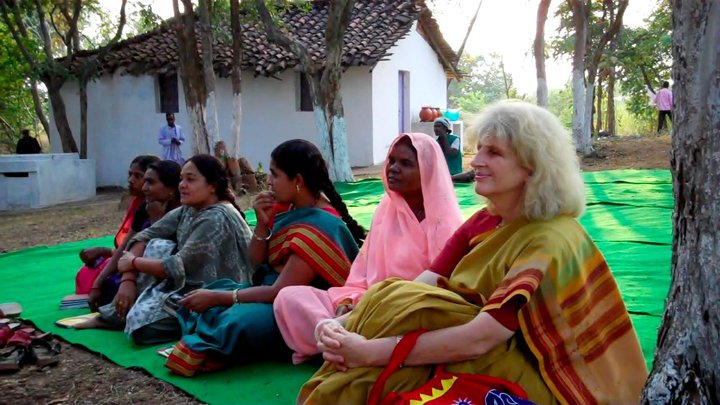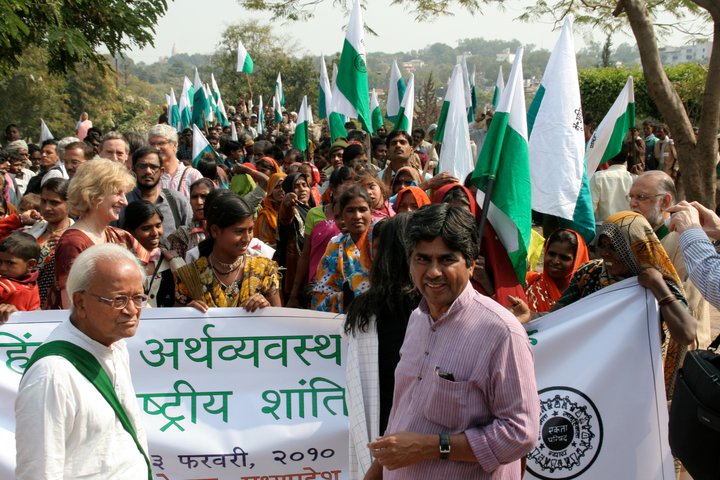There has been a big discussion about what is more effective during class struggle, Gandhian nonviolent strategy or going back to Leninist or Stalinist methods of violent uprising. The Indian movement of landless people Ekta Parishad has been around for the last 12 years.
Rajagopal PV and Jill Carr-Harris have been involved in this movement since its beginning. They have been landless and have not owned any property like many others involved in Ekta Parishad. In 2007 this movement had its first significant achievement when the government satisfied a number of demands put forward by the peaceful protesters. Last September Geneva hosted the "International Mobilization Conference on The Right to Land and Livelihood.’" In October 2012 Land Satyagraha is going to take place in India.
I was interested to learn how to change our discourse to better reflect the situation of the landless. This is quite a distinct group from the proletariat and in many cases it is even more oppressed. So I have asked Jill Car-Harris questions about upcoming Satyagraha and changing the discourse on landless. Here is my conversation with her:
IK.This is one of the first cases of Satyagraha that is organized on demands that are mostly socio-economic. Obviously the problems of land and poverty right now are at the forefront around the world. What do you think could be achieved with this protest?
JC-H.Ekta Parishad has been organizing a cycle of satyagrahas (social actions using moral force) for the past 12 years so this is not the first. As the Indian state has laws in place to distribute land to the landless we are asking the Indian government to work within the law and to address the issue of landlessness. This is a legitimate right of people to get a piece of land. It is socio-economic in the sense that it is aimed at reducing poverty, but it is also political. It is also about ensuring that the governance system responds to everyone’s democratic right fairly. Right now the Indian government is much more apt to provide land to the corporations undertaking industrial agriculture, manufacturing or mining, than it is to be the people whose land claims have remain unanswered for many years.
What can be achieved by this satyagraha (different from a protest) is that it can give social power to a group of people who remain powerless in the society. A march is their language to express the inequity. The inequity will become visible whether the state wants this or not. It is then up to the state to decide whether it will respond to the dire land needs of growing population of landless poor. They have in the past, so we are confident they will do so in future.
IK. Do you see any similarities between your movement and Occupy Wall Street? Since Occupy Land in Brazil was also related to land issues, what do you think is a common ground between these movements?
JC-H. The Occupy Wall Street and other Occupy movements are about making visible issues of inequity so in this way they are similar.
The difference however is that Ekta Parishad has had a capacity building process on non-violent action in place for more than 20 years, and this has enabled local leaders to grow up and lead the movement. For that reason it is a sustained social movement.
IK. The new technologies—social networks and other internet capabilities have changed the landscape in the world of communication. Gandhi was emphasizing the role of positive public relations during his Satyagraha and he had his stories reported in Western press. Do you think that new technologies could be useful in making Satyagraha more widespread? 
JC-H. There is no doubt that the social media is a way of disseminating information at a rapid rate. In India the use of social media is increasing but not yet at the place where people are in the west are in terms of public organizing. Most of our supporters are without social media in villages. People-to-people contact is still vital to building a non-violent social movement. However educated middle-class urban-based youth in India do communicate through social media. There is a growing number interested in supporting Ekta Parishad but it is still a small segment of the population.
IK. The question of economic exploitation and oppression again became one of the leading issues that is discussed around the world right now. We can resurgence of Marxism and even Leninism in some form. But there is not much talk about the non-violent international movement, if we say so, non-violent Satyagraha around the world with the socio economic demands. Do you think it will be useful to start to look trans-national and have coordinated actions around the world, including Europe, United States, African countries, Russia, Latin America, etc.?
JC-H. There are arguments being made that the 21st century is the century of non-violent struggle. I believe this. It is easier when nation states have a democratic framework of governance because then people’s satyagraha within is not threatening to the state that has a robust democracy. Satyagraha is about people suffering to gain justice. This is based on notions that run counter to a society that believes that social change can happen without any discomfort. Social change requires transformative processes and these are never easy. It is for this reason that people need a gradual leadership training in non-violence in order to be able to carry it out in a sustained manner.
It is hoped that different countries will carry out simultaneous actions during our Jan Satyagraha. It is up to different organizations to respond as they see fit and find ways to coordinate among themselves.
IK. The strategy of non-violent struggle has proved that is was most successful in 20th century. Gandhi's struggle was followed by the Civil Rights Movement in the United States, non-violent liberation of Former Soviet colonies, transformation of Apartheid into democratic system, etc. But somehow many leading political theorists have a problem in endorsing Ahimsa. What do you think is the reason for this?
JC-H. I think that few people understand the Gandhian social movements after Gandhi in India. There were many that took place like J.P. Narayan’s movement, Boudhgaya movement, and many others including the contemporary movement of Ekta Parishad. It is our hope that participation in the Jan Satyagraha this October will reaffirm that non-violence still works in closing the gap between the rich and the poor and raising governance issues. It is slower than violent movements but it has more sustained change. There is no point replacing one interest group with another without a change in the way power is mediated to ensure more equity. This is the reason why I think Gandhian non-violent movements still have relevance.
IK. What can believers of non-violence do in today's situation when the neoliberal system is basically taking all our rights as free citizens and it has developed very sophisticated methods of manipulating and ruling billions of people? How could we start an international Satygraha that would lead to some real reforms in economic life?
JC-H. The effort is to have a bottom-up development. Gain people’s engagement at the bottom-level in political decision-making. Without that people lose control over their democratic rights. Simultaneously people need to gain control of socio-economic rights to reinforce the political rights. For instance Ekta Parishad is talking about resource rights of the poor in the global south, which are moving into the hands of fewer and fewer people. So what we are doing is changing the narrative. These are not natural resources they are livelihood rights to water, forest and land which people need for subsistence and generating livelihoods. This is also important for guaranteeing food security, cultural life and social power. By reclaiming people’s local control over their livelihood resources, they are able to develop and get out of acute poverty.
IK. Many political theorists forget that Gandhi's 'Constructive Program' and "Swadeshi" has addressed the question of economic sustainability and economic justice, Gandhi's campaign for "Harijan" is very much applicable not just to the people of India, but billions of dispossessed and disenfranchised around the world. 'Swadeshi' was a predecessor of Green Economy in many ways. Do you think it makes sense to try to start an international campaign for "Swadeshi" together with different countries?
JC-H. There is increasing resonance with swadeshi today in say, the local food movements. The Gandhian concept of Swadeshi means building local self-sufficiency through constructive programs. Ekta Parishad takes up constructive programs in strengthening self-reliant communities, which allow people to be independent of the systems of violence that perpetuate poverty. Gandhi did have a different concept of state than the modern European state. He saw swadeshi succeeding where India was 500,000 villages interacting with each other. Whether the emerging green economy is moving towards local production is yet to be seen. Certainly there are many lessons to be learned from the Indian experience of village industries; small and medium industries in the past 64 years.
IK. Many people think that Karl Marx's word "Proletariat' is not completely adequate to portray the situation with the economic oppression today. Others talk about the term "Subaltern". These people are obviously not just unemployed industrial workers in postindustrial society. Gandhi had a term 'Harijan'. Do you think we need to have another word for this?
JC-H. Gandhi used harijan (people of god) because his talisman was ‘to think of the poorest person when you took on any planning’. However the broader concept was sarvodaya (well-being of all). This is where there is a difference with western concepts of oppressor and oppressed that are based on binaries of power. In the Indian worldview, there is a holism, which does not distinguish opposites. Reform happens within the system. For that reason the concept of Satyagraha was developed to have people change themselves within a system. It is not about creating polarities. But having a higher consciousness so one can participate in a sarvodaya (thinking of the whole rather than individual self-interest). Satyagraha is a way of changing behavior to minimize the ego that is fundamental to self-interest. Satyagraha moves people naturally towards collective interest without losing the freedom of the individual towards their own liberation.
IK. What are the future plans for Satyagraha beyond the October protest?
JC-H. The Satyagraha in October is part of an ongoing cycle of action that has been going on for twelve years and that will continue. Hopefully in the process there will be a reformist trend within the Indian Government to advance land reform before the 2013 election. Gandhian non-violent social movements use both moral power and political strategy in reaching their objectives.



